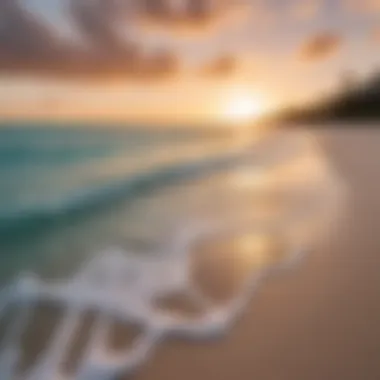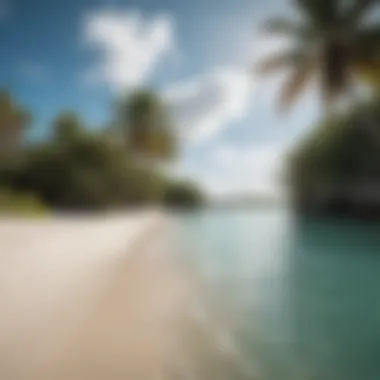Explore the Beaches of Turks and Caicos: Weather Insights


Intro
The beaches of Turks and Caicos are more than just a postcard-perfect escape; they offer a climate influenced by the whims of the Caribbean weather. Understanding these conditions can be the difference between a day spent soaking up the sun and one spent dodging rain. This guide aims to provide kiteboarders, travelers, and beachgoers the critical insights needed to navigate the ever-changing atmosphere.
In the coming sections, we will look closely at the regional weather patterns, essential gear selections for kiteboarding, skill development tips, and practical advice to ensure your beach experience is not just enjoyable but also safe. Whether you’re gliding across the azure waters or relaxing on the shore with a good book, having the right information at hand can massively enhance your stay.
Weather in these islands changes throughout the year, influenced by factors such as air pressure, trade winds, and sea temperatures. By exploring these elements, you will be better equipped to choose the ideal time to visit, allowing for an optimal experience at those stunning shores.
Gear Selection
It's essential that kiteboarders choose the right equipment to tackle the conditions found in Turks and Caicos. The appropriate gear not only enhances performance but also promotes safety.
Types of Kites
When selecting a kite, many factors come into play, such as wind conditions and your own skill level. Here’s a quick rundown of various kite types you might consider:
- Foil Kites: Best for light wind conditions, these kites provide a smooth experience on calm days.
- LEI Kites (Leading Edge Inflatable): Great for strong winds, they deliver stability and power, making them suitable for more experienced riders.
Always remember to consider wind speed and your intended use. Whether you are racing, jumping, or cruising, the right kite can make a world of difference.
Choosing the Right Board
Just as important as the kite is the board you choose to ride. Selecting the right board can enhance your comfort and performance. Here are a few types to consider:
- Directional Boards: Ideal for wave riding and provide excellent control. They're a must if you plan to tackle the surf.
- Twin-Tip Boards: These boards allow you to ride in either direction and are perfect for freestyle tricks and general riding. They're often recommended for beginners as they offer greater versatility.
Your choice of board should harmonize with your skill set and the expected conditions. A well-matched board and kite can elevate your kiting experience significantly.
"Choosing the right gear shouldn’t be a hasty decision; it can fundamentally alter your enjoyment on the water."
Skill Development
Progressing your kiteboarding abilities requires not just practice but also guidance on essential techniques. As you explore the beaches, consider the following tips to refine your skillset.
Essential Techniques
The foundation of solid kiteboarding skills lies in mastering basic techniques. Here are some of the key elements to focus on:
- Body Dragging: This skill teaches how to maneuver through the water without the board, essential for recovering if you lose it.
- Water Launching: Practice launching your kite directly from the water which can save time and energy, especially in fluid situations.
Progression Tips
As you become more comfortable, consider these progression tips:
- Set Goals: Whether it's mastering a new trick or simply improving your confidence, having clear goals can guide your practice sessions.
- Seek Feedback: Don't hesitate to ask for feedback from instructors or fellow kiteboarders. Learning from others can drastically improve your skills.
By honing these techniques and being mindful of your equipment selection, kiteboarders can truly enjoy their time on the stunning beaches of Turks and Caicos.
Prelude to Turks and Caicos
Turks and Caicos, a tropical paradise nestled in the Caribbean, offers an alluring escape for those looking for breathtaking vistas and a unique beach culture. This section serves as a portal into understanding why these islands are of paramount importance not just from a geographical perspective but also in the realms of history and culture. For travelers, the significance lies in knowing the physical and historical context of these islands, as it enhances the overall experience of vacationing or kiteboarding here.
Understanding the dynamics of the locale helps both enthusiasts and event organizers plan their visit with greater insight. The vagaries of weather are ever crucial in such coastal regions, making the knowledge of local geography essential to maximize enjoyment.
Geographical Overview
Located southeast of the Bahamas, the archipelago consists of about 40 islands and cays, though only a few are inhabited. The islands are primarily flat, with the highest point being a mere 50 feet above sea level. The most renowned of these is Providenciales, home to Grace Bay Beach, which has garnered accolades for its stunning beauty.
Turks and Caicos is ensconced in the Caribbean Sea, making it a sought-after destination for those eager to bask in warm sunshine and explore aquamarine waters. The geography of the islands plays a vital role in defining the weather patterns—specifically the trade winds that create the ideal conditions for kiteboarding, as well as the temperate climate that draws visitors year-round.
Historical Context
The historical narrative of Turks and Caicos is rich and layered, with a blend of indigenous Taino and Lucayan cultures followed by European colonization. The islands were largely uninhabited until the discovery by Christopher Columbus in 1492. Spanish and British rule shaped much of the islands' development, which included the establishment of cotton and salt industries.
Interestingly, the cultural remnants from these eras remain intertwined with contemporary life. For kiteboarders and enthusiasts, understanding this historical backdrop can enrich their appreciation of the surroundings, as certain equestrian and nautical traditions trace their roots back to these early influences.
Cultural Significance


Culture in Turks and Caicos is a vibrant mix of African, European, and Caribbean influences, representing an identity that is uniquely their own. Festivals, music, and cuisine reflect this rich heritage—contemporary cultural expressions still echo the past through colorful events like the Junkanoo Festival.
This cultural tapestry directly impacts the beach-going and kiteboarding experience. Engaging with local customs and communities can provide insights about the best times and places to enjoy the islands, as well as where to paddle your board when the winds are just right. Overall, knowledge about the cultural significance of these islands informs visitors’ interactions and experiences, enhancing their stay beyond mere enjoyment of sunny skies and soft sands.
"Embracing the local culture is like catching the perfect wave; it elevates the entire experience."
In summary, understanding Turks and Caicos through its geographical layout, historical context, and cultural significance is not merely academic—it's a guiding compass for maximizing enjoyment and safety while visiting. Whether you are a kiteboarder or a traveler seeking relaxation by the sea, these insights will empower you to navigate this Caribbean gem with clarity.
Understanding Weather Patterns
Weather patterns significantly shape your experience on the beautiful beaches of Turks and Caicos. For enthusiasts, kiteboarders, and casual beach-goers alike, knowing these patterns can be the difference between a sun-soaked holiday and one spent indoors. This section breaks down the key aspects of the region’s climate, offering insight into how various weather elements can either enhance or hinder your outdoor adventures.
Climate Classification
The climate in Turks and Caicos can be classified as tropical marine, characterized by warm temperatures and relatively high humidity all year round. This classification means you can expect pleasant weather most days, making it a prime destination for vacationers seeking sun. The average temperature ranges from 75°F to 85°F during most months. However, understand that being aware of potential changes and trends in the climate helps in planning the best times for visiting.
Seasonal Variations
Understanding the seasonal variations is crucial, as each season brings its own flavor and personality to the beaches. Let's delve into each one:
Winter Weather Conditions
Winter in Turks and Caicos is a rather mild affair. From December to February, temperatures hover between 70°F and 80°F, making it a peak season for tourists escaping the cold north. This time of year offers a delightful balance, with plenty of sunshine but cooler evenings. However, the north winds may kick up the waves, particularly in January. While it's a popular choice because of the lovely temperatures, it’s wise to be prepared for occasional windy days that could affect water activities.
Spring Transition
As winter gives way to spring, the weather starts to shift. March signals the transition into warmer days with temperatures nudging upwards. The winds begin to die down, providing ideal kiteboarding conditions, especially in April. The spring transition is a great time for families and adventurers alike, as it allows for extended hours on the beach without feeling the scorching heat of summer. Though there may be higher humidity, it often doesn’t deter activities, ensuring a comfortable stay for most.
Summer Heatwaves
Summer lasts from June to September and can be quite warm. With temperatures reaching up to the high 90s, this season often leads to intense heat, making beach lounging a top priority. The high temperatures can benefit kiteboarding during the early mornings and late afternoons when breezes are more constant. Conversely, midday can feel stifling; hence, a little bit of shade and some fresh coconut water can go a long way. Just be mindful of hydration and sun protection during this season.
Autumn Changes
Autumn begins in October, bringing a change in the atmosphere and a gradual decrease in temperatures as it heads towards winter. This period can bring increased rainfall, though typically light. While the weather can be somewhat unpredictable, it’s also less crowded compared to peak seasons. The waves are often calmer, making it an excellent time for those looking to enjoy quieter beach days or a relaxed kiteboarding experience. However, be prepared for the occasional tropical storm, as this time of year sits right in the path of such weather systems.
Rainfall Patterns
The rainfall patterns in Turks and Caicos are rather intriguing. Most of the year is dry, but the rainy season primarily falls between May and October, with occasional showers. These often happen at night or in the early hours, leaving plenty of time for sunny activities during the day. Each season brings different rainfall discussions, so keep an eye on forecasts before heading out. By understanding and respecting these patterns, one can tailor their activities to make the most out of their time on the islands.
"Planning your beach visit with weather intel ensures your experiences remain enjoyable and safe."
Armed with knowledge about these weather patterns, you’re now ready to dive deeper into specific beach experiences and considerations, ensuring your trip to Turks and Caicos is memorable.
Beaches of Turks and Caicos: An Overview
Turks and Caicos is renowned for its stunning coastlines and crystal-clear waters. The beaches here are not just for sunbathing but offer a wide variety of experiences that cater to both thrill-seekers and relaxation enthusiasts. Understanding these offerings is crucial for anyone planning a visit. Knowing what each beach provides, especially in terms of access, amenities, and weather can greatly enhance your trip's success.
Grace Bay Beach
Accessibility
Grace Bay Beach stands out for its unrivaled ease of access, making it a top pick for tourists. Located close to Providenciales International Airport, getting to this beach is as simple as a short drive or shuttle ride. The smooth roads and well-marked routes help navigate this otherwise hidden gem with no headaches. This convenience plays a pivotal role in its popularity, drawing in beachgoers who want to dive right into their vacation without delay.
One notable feature is the nearby parking and various public access points, which ensure that anyone can enjoy the scenery. However, during peak season, the accessibility may shift a bit as crowds tend to pour in.
Local Amenities
The local amenities around Grace Bay enhance the overall experience for visitors. Alongside soft white sands, you’ll find numerous beach resorts, restaurants, and shops lining the coast. It is like having a mini-village right at the shoreline, all catering to your beach needs. From beachfront dining to water sports rentals, the options are plentiful.
A unique characteristic of this setup is the variety of dining experiences available. You can choose to indulge in a high-end meal or grab a quick bite from a casual beachside café. However, this array of amenities sometimes leads to a bustling atmosphere, which may detract from those seeking a more secluded experience.
Weather Considerations
Understanding the weather at Grace Bay is essential for any beachgoer. During winter months, light breezes and delightful temperatures make it ideal for both sunbathing and water sports. Summer, on the other hand, brings higher temperatures that can be intense but often include refreshing trade winds.
One significant feature to note is the reliability of the weather patterns. Travelers typically enjoy plenty of sunshine, but awareness of potential tropical storms in late summer is crucial. Being informed about weather conditions allows visitors to plan their days effectively.
Long Bay Beach


Kiteboarding Conditions
Long Bay Beach is the kiteboarding paradise of the islands. With consistent winds ranging from 15 to 25 knots, it provides ideal conditions for both inexperienced and seasoned kiteboarders. The large stretches of flat water also make for an inviting environment to practice tricks or just cruise along.
The primary characteristic that makes this beach appealing for kiteboarders is its spaciousness. Unlike other beaches that may get crowded, Long Bay allows plenty of room to maneuver safely. However, windy conditions can sometimes be a double-edged sword — the same breeze that delights kiteboarders can also pose challenges for newer athletes who are still honing their skills.
Water Sports Opportunities
In addition to kiteboarding, Long Bay Beach is a hub of water sports activities. From paddleboarding to kayaking, the beach offers a versatile playground suited for enthusiasts of all kinds. The warm waters tempt thrill-seekers and families alike to engage in various fun activities.
One of the unique features here is the presence of rental shops that cater specifically to diverse water sports. So whether you're a seasoned pro or just a casual adventurer, you’ll find equipment and guidance readily available. However, as water sports gain popularity, special care must be taken to avoid overcrowding.
Sapodilla Bay
Serenity and Calm Waters
Sapodilla Bay stands apart with its serene ambiance and calm waters that feel almost like a private retreat. This beach is perfect for those looking to escape the hustle and bustle of the more popular stretches. The shallow, warm waters are often a child’s playground, allowing little ones to splash about under careful supervision.
One significant aspect of this peaceful environment is that it tends to attract fewer crowds, creating a more intimate experience. As much as this serenity appeals to families, it's also inviting for those just needing to unwind without distractions. How often do you find a place that combines genuine beauty with tranquility?
Family-Friendly Environment
The family-friendly environment of Sapodilla Bay makes it an ideal destination for parents traveling with children. Beyond the calm waters, the beach is surrounded by shallow areas that are excellent for young kids to explore safely. Parents can relax knowing their children are enjoying the waters without worrying about deep currents.
One important characteristic is the close-knit community feel of the area. Sapodilla features local food stalls and family-run establishments, which adds to its charm. However, without the range of commercial amenities found at other beaches, families seeking extensive entertainment options might want to keep this in mind as they plan their stay.
Kiteboarding Conditions in Turks and Caicos
Kiteboarding in Turks and Caicos is not just a pastime; it’s an experience closely tied to the unique weather conditions that define the region. Kiteboarders, whether seasoned or beginners, can certainly appreciate how the interplay of winds, temperature, and water conditions can enhance their enjoyment on the waves. This section digs into critical elements such as the best time to hit the water, specific beaches to explore, and what conditions make the Turks and Caicos an ideal kiteboarding destination.
Best Time for Kiteboarding
Seasonal Wind Patterns
Understanding seasonal wind patterns is crucial for anyone looking to kiteboard in Turks and Caicos. The trade winds, which are typically consistent between November and August, play a significant role in creating optimal kiteboarding conditions. Generally, these winds blow from the east at a speed of 15 to 25 knots. The key characteristic of this wind pattern is not just its strength but also its reliability; kiteboarders can often expect predictable afternoons with ideal wind speeds.
Aside from the steady winds, what also stands out about the seasonal wind patterns is their ability to provide thrill and excitement. Plan your trips around these months to take advantage of the gear you’ll want to bring along, ensuring you get the most out of your kiteboarding adventure. However, be mindful that the peak season can also lead to crowded beaches, so finding a unique spot may take some exploration.
Temperature Influences
Temperature is another key factor for kiteboarding conditions, as it sets the scene for comfort while on the water. The tropical climate of Turks and Caicos makes it an attractive option year-round, with average daily temperatures ranging between 75°F and 90°F (24°C to 32°C). This warm, inviting climate enhances the overall experience.
One interesting aspect of temperature here is its effect on water conditions. Warmer waters tend to lead to an increased number of kiteboarders, making waves more familiar and manageable for beginners. Conversely, when temperatures dip slightly during the winter months, you may encounter fewer riders but also cooler winds, which can be both a pro and a con depending on your skill level. It’s not unusual to see avid kiteboarders fully suited up and enjoying the winds, whilst others might need to cozy up after an exhilarating kite session.
Recommended Beaches for Kiteboarding
Long Bay Beach
Long Bay Beach is often touted as a kiteboarding paradise, and for good reason. The beach's expansive shoreline, combined with its shallow waters and stead winds, makes it particularly suited for beginners and seasoned riders alike. The unique feature of Long Bay is its east-facing orientation, providing consistent trade winds that enhance the overall riding experience.
Additionally, close proximity to local amenities ensures that you have everything you need to make the most of your visit. However, do keep in mind that while it can get busy, especially during peak kiteboarding season, there are plenty of less-trafficked areas along the beach where you can set up without feeling crowded.
Half Moon Bay
Half Moon Bay is another premier location for kiteboarding, often favored for its natural beauty and uncrowded conditions. Nestled on the southeastern coast, it appeals to those who prefer a more serene environment. The unique characteristic here is the calmness of the waters, influenced by the surrounding coral reefs, which help to moderate the waves, making it an excellent choice for those learning the ropes.
The picturesque setting doesn’t hurt either; with stunning views and soft sands, every session feels special. However, it’s worth noting that the exposure to the north can result in less consistent winds, so double-checking the forecast is wise before heading out. Nonetheless, for those looking for a kiteboarding spot off the beaten path, Half Moon Bay is truly a captivating option.
In summary: Kiteboarding in Turks and Caicos offers a thrilling and engaging way to enjoy this tropical paradise. Understanding the wind patterns and temperature influences can significantly enrich one’s experience, alongside selecting the right beaches for an optimal outing.
Practical Considerations When Visiting
When venturing to the beautiful beaches of Turks and Caicos, it's crucial to grasp the practical matters that can significantly influence one's experience. Knowing how to navigate travel logistics, local transport systems, and accommodations can mean the difference between a stress-free vacation and a spot of bother. Here, I’ll delve into these elements, shedding light on how they help in creating a seamless experience, especially for kiteboarders and beachgoers alike.
Travel Recommendations
Flight Options
Startin' with flight options, securing the right air travel can ease the journey a great deal. Major airlines frequently operate routes to Providenciales International Airport, which is the main gateway to the islands. The key characteristic here is that many flights come with relatively reasonable fares, particularly during the off-peak months. This makes it a beneficial choice for budget-conscious travelers, especially those looking to maximize their beach time without breaking the bank.


There are seasonal variations that could affect pricing and availability. Usually, booking well in advance or being flexible with travel dates can yield significant savings.
For those coming from the United States, direct flights from cities like Miami or New York make the trip straightforward. However, keep in mind that not all airlines provide the same level of comfort or reliability, so it helps to read reviews to find the right fit for your needs.
Local Transport
Once you touch down, understanding local transport can make moving around a breeze. In Turks and Caicos, you generally have a few options ranging from taxis to car rentals. The predominant feature is that while taxis are readily available, they tend to be a bit on the pricey side—not the most budget-friendly choice for long-distance travel.
On the other hand, renting a car offers greater flexibility and might actually end up being more economical if you're planning to explore different beaches or visiting more remote spots. Just be aware that driving is done on the left side of the road, a detail that could catch some off-guard.
Public transport is somewhat limited, but there are local buses, mainly for the budget-savvy traveler. While not as frequent, these can be a worthwhile experience, allowing for a more authentic connection with the islands. However, ensure to check schedules ahead of time since they might not always align with tourist activities.
Accommodation Insights
Beachfront Resorts
Transitionin' to accommodation, beachfront resorts often fetch first place in the minds of most visitors. These establishments provide easy access to pristine sands and azure waters, making them a beloved choice for any beach lover, particularly kiteboarders who want proximity to the best spots. The main draw is the convenience—stepping out of plush accommodations and right onto the beach is a dream scenario.
However, it’s worth noting that some resorts can be on the pricier side. While they provide luxurious amenities and activities, including spa services and on-site dining, ensure the resort aligns with your budget and what you’re looking for in terms of experience.
Budget-Friendly Choices
For those who keep a closer eye on expenses, budget-friendly choices are scattered around the islands as well. From guesthouses to small boutique hotels, there are plenty of options that offer a cozy stay without emptying your wallet. Not only do these options allow you to save some cash for local adventures, but they often provide a more intimate experience of island life.
It’s important to read the reviews to get a feel for what each place offers. Some might surprise you with excellent service and friendly staff at a fraction of the cost of fancier resorts. A unique trait here is that many budget options also have kitchens, letting you whip up your meals and sample local products—great for those who want to stay nourished without spending a fortune eating out.
"A well-planned visit opens the door to unforgettable adventures and hidden gems."
By pinpointing essential travel logistics, understanding transportation options, and choosing the right place to stay, visitors can plan their trip with ease, ensuring their time spent soaking up the sun and riding the waves isn’t marred by avoidable hiccups. Every detail counts when it comes to fully embracing the beauty of Turks and Caicos.
Safety and Environmental Awareness
Understanding safety and environmental awareness is of utmost importance when exploring the breathtaking beaches of Turks and Caicos. This region not only offers stunning vistas but also a unique ecosystem that requires respect and protection from both locals and visitors. Ensuring awareness around these aspects is essential for creating a sustainable travel experience and preserving the natural beauty for future generations.
Understanding Local Weather Alerts
Weather can turn on a dime. In the Caribbean, it’s all sun and fun until it isn't. Local weather alerts play a crucial role in ensuring safety, particularly for activities such as kiteboarding, which can be deeply affected by sudden changes in wind patterns and storms.
Understanding how to interpret weather alerts can mean the difference between an enjoyable day out on the waves and a potential hazard. The government and local meteorological services routinely provide updates and warnings about severe weather, such as tropical storms or hurricanes, that could impact beach conditions.
It's advisable to stay tuned to these alerts through various channels:
- Local news channels: Always a reliable source for real-time information.
- Mobile apps: Weather apps such as Weather Underground or AccuWeather provide instant alerts.
- Social media: Following local tourism boards on platforms like Facebook can keep you in the loop.
Take heed to warning flags on the beaches. A red flag signals dangerous conditions, while yellow suggests caution is warranted.
"When you ignore weather warnings, you risk not just your own safety, but also that of others enjoying the paradise."
Environmental Conservation Efforts
The beauty of Turks and Caicos is not just in its beaches but also in its vibrant wildlife and unique marine ecosystems. Conservation efforts are vital to the longevity of these natural resources. Local organizations, along with the government, actively work to maintain and restore the environment.
Several initiatives focus on protecting coral reefs, which are the backbone of marine life here. These reefs work as a natural barrier to waves and provide shelter to a variety of species. Travelers can engage in:
- Beach cleanups: Join local groups in their efforts to keep the beaches pristine.
- Responsible snorkeling and diving: Avoid touching reef structures to preserve them and be mindful of your surrounding.
- Eco-friendly products: Choosing reef-safe sunscreens aids in protecting the delicate balance of the underwater ecosystem.
By taking part in these efforts, visitors can contribute to sustaining the natural allure of the islands, ensuring that future generations can continue to bask in the sun, sand, and sea that makes Turks and Caicos so special.
Closure
When planning a visit to Turks and Caicos, understanding the multifaceted weather conditions isn't just a nice-to-have—it's essential for ensuring a delightful beach experience. The information explored throughout this article serves as a guide that informs not only ordinary travelers but also enthusiasts and kiteboarding fans seeking the optimal conditions for their specific activities.
It's clear that the climate here is distinctive, exhibiting variations throughout the year that affect everything from beach accessibility to water sports conditions. For kiteboarders, knowing when the winds favor their sport can lead to unforgettable moments on the water. The outlined seasonal variations, especially how winter presents milder weather while summer heats things up, underpin a key advantage for planning a trip that aligns with personal preferences.
Additionally, the insights provided on local weather alerts and conservation efforts emphasise the importance of being mindful of one’s surroundings. Being prepared means not just enjoying the beaches but also contributing positively to the beautiful environment that the islands boast. By considering all the relevant factors from this guide, travelers can optimize their itineraries, relish in the stunning landscapes, and fully appreciate the natural beauty of Turks and Caicos.
Ultimately, this article serves as a roadmap for anyone aiming to make the most of their beach expedition, demonstrating that a well-thought-out visit can transform a good holiday into a truly memorable experience.
Final Thoughts on Visiting
Before embarking on your journey to Turks and Caicos, understanding the prevailing weather conditions is paramount. Each beach showcases its own charm and set of conditions, beckoning visitors with the promise of leisure and adventure. Grace Bay might be bustling with families, while Sapodilla Bay offers serene calm for those chasing tranquility.
Reflect on the experiences shared in the previous sections; know when kiteboarding conditions are at their peak or when rainfall may interfere with a planned outing. Engaging with local culture and respecting environmental initiatives enhances the travel experience. Enjoying the sun while remaining aware of possible weather changes makes all the difference. Having up-to-date information on everything from local amenities to seasonal trends can greatly transform how one interacts with these scenic landscapes. It's not just about the places you visit, but how prepared you are to marvel at their beauty.
Ultimately, each visitor to Turks and Caicos should aim to leave not just with memories but also a deeper appreciation for this uniquely curated paradise.















